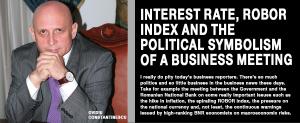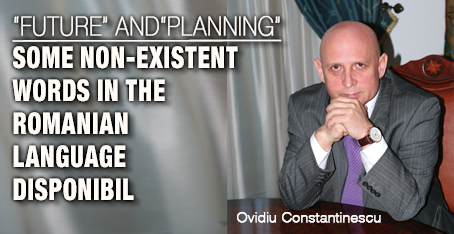Interest rate, ROBOR index and the political symbolism of a business meeting
I really do pity today's business reporters. There's so much politics and so little business in the business news these days. Take for example the meeting between the Government and the Romanian National Bank on some really important issues such as the hike in inflation, the spiraling ROBOR index, the pressure on the national currency and, not least, the continuous warnings issued by high-ranking BNR economists on macroeconomic risks.
Such a meeting should have been a rather technical exercise with loads of tables and graphs spread over the desk, a meeting ending with a brief press release on both parties’ efforts to ensure a steady and sustainable economic growth, to keep Romania within the EU deficit target, maintain a stable currency and ensure a smooth path towards joining the eurozone. For such meeting, the building of the Ministry of Finance would have been a fair and natural venue.
However, this wasn’t meant to be a mere technical exercise or a game between two economic wizards. As the meeting followed a string of open accusations launched by leading representatives of the ruling Romanian Social-Democrat Party (PSD) that BNR was undermining “the governing program”, the political symbolism of the meeting was more important than the discussions. Those who would diktate (no, “diktate” is not misspelled) the place and the agenda, would be more important than the actual problems which, by the way, were extremely important and deeply worrying.
So, enter the scene the Romanian President, Mr. Klaus Iohannis, who offered his services to bring the two independent institutions, i.e. the Government and the National Bank, to the mediating table, at the Cotroceni Palace.
“Thank you, but no, thank you,” said Finance Minister Eugen Teodorovici, worried that the President may actually steal the spotlight with an after-meeting press declaration, in which he may actually accuse the government that the current situation was simply the result of the irresponsible and unsustainable salary raises in the public sector promoted by the Labor Minister, Miss. Olguta Vasilescu, doubled by the chaos created by the so-called “fiscal revolution” successfully implemented by the head of the Nation Agency for Fiscal Administration, Mr. Ionut Misa, by the introduction of special pension schemes for politicians and high-ranking police and gendarmerie officers, which were voted with both hands by the PSD members of the Parliament.
Furthermore, the image of former Prime Minister Victor Ponta and his Finance Minister, Miss. Ioana Petrescu, being humiliated by the former President Basescu over the MTO issue was still fresh in the public’s memory and so who would dare take the risk with Dancila?
With the Cotroceni Palace location out of the question, the third natural option would have been the Government. However, the prospect of having the current Prime Minister, Mrs. Viorica Dancila, host such a meeting and summarize its results live, in front of the media, made it a non-option.
So, in the end, they all met at the Parliament, in the building of people’s chosen ones, and in the office of the Chamber of Deputies’ Chairman, Mr. Liviu Dragnea, to be more precise. It is my feeling that Mr. Liviu Dragnea is trying to make the Chairman of the Social Democrat Party the most powerful man in the country once again, with a power of decision never seen before since Nicolae Ceausescu. Yes, my dear friends, you’ve been warned: Liviu Dragnea is not daydreaming of the good old days, when crucial decisions were not made by the Prime Minister or by the head of the state (i.e. the Chairman of the Great National Assembly, before March 1974, when Nicolae Ceausescu invented the position of the President of the Socialist Republic of Romania), but by the Secretary General of the Romanian Communist Party. The fact that the “Secretary General” of the Party felt entitled to summon the head of the supposedly independent National Bank and the later submitted to the call was extremely important from a symbolic point of view.
Also, highly symbolic was the fact that Mr. Isarescu was only accompanied by Mr. Florin Georgescu, probably the “reddest” Vice-Governor of the Romanian National Bank. Georgescu was Finance Minister in the Vacaroiu government (1992-1996), the one that made sure that the government’s money-printing machine went into overdrive in the ‘90s, a measure that brought hyper-inflation at the end of the decade.
Having said that, there is still hope that not all went according to plan. The fact that the Chamber of Deputies’ press department reinvented the silent movie, releasing footages from the meeting without sound is an indication. The other indication is the post-meeting press release with the “exogenous” factors that impeded Romanian economy’s leap forward, an explanation mocked by commentators. But the most important aspect was the letter of discontent sent by Mr. Dragnea to Mr. Isarescu after the meeting and the long and detailed written reply by the Governor of the Romanian National Bank. And I don’t think Mr. Isarescu is ready to keep his mouth shut, as nervously requested by Liviu Dragnea, the Secretary General of the Romanian almost Communist Party.
However, this wasn’t meant to be a mere technical exercise or a game between two economic wizards. As the meeting followed a string of open accusations launched by leading representatives of the ruling Romanian Social-Democrat Party (PSD) that BNR was undermining “the governing program”, the political symbolism of the meeting was more important than the discussions. Those who would diktate (no, “diktate” is not misspelled) the place and the agenda, would be more important than the actual problems which, by the way, were extremely important and deeply worrying.
So, enter the scene the Romanian President, Mr. Klaus Iohannis, who offered his services to bring the two independent institutions, i.e. the Government and the National Bank, to the mediating table, at the Cotroceni Palace.
“Thank you, but no, thank you,” said Finance Minister Eugen Teodorovici, worried that the President may actually steal the spotlight with an after-meeting press declaration, in which he may actually accuse the government that the current situation was simply the result of the irresponsible and unsustainable salary raises in the public sector promoted by the Labor Minister, Miss. Olguta Vasilescu, doubled by the chaos created by the so-called “fiscal revolution” successfully implemented by the head of the Nation Agency for Fiscal Administration, Mr. Ionut Misa, by the introduction of special pension schemes for politicians and high-ranking police and gendarmerie officers, which were voted with both hands by the PSD members of the Parliament.
Furthermore, the image of former Prime Minister Victor Ponta and his Finance Minister, Miss. Ioana Petrescu, being humiliated by the former President Basescu over the MTO issue was still fresh in the public’s memory and so who would dare take the risk with Dancila?
With the Cotroceni Palace location out of the question, the third natural option would have been the Government. However, the prospect of having the current Prime Minister, Mrs. Viorica Dancila, host such a meeting and summarize its results live, in front of the media, made it a non-option.
So, in the end, they all met at the Parliament, in the building of people’s chosen ones, and in the office of the Chamber of Deputies’ Chairman, Mr. Liviu Dragnea, to be more precise. It is my feeling that Mr. Liviu Dragnea is trying to make the Chairman of the Social Democrat Party the most powerful man in the country once again, with a power of decision never seen before since Nicolae Ceausescu. Yes, my dear friends, you’ve been warned: Liviu Dragnea is not daydreaming of the good old days, when crucial decisions were not made by the Prime Minister or by the head of the state (i.e. the Chairman of the Great National Assembly, before March 1974, when Nicolae Ceausescu invented the position of the President of the Socialist Republic of Romania), but by the Secretary General of the Romanian Communist Party. The fact that the “Secretary General” of the Party felt entitled to summon the head of the supposedly independent National Bank and the later submitted to the call was extremely important from a symbolic point of view.
Also, highly symbolic was the fact that Mr. Isarescu was only accompanied by Mr. Florin Georgescu, probably the “reddest” Vice-Governor of the Romanian National Bank. Georgescu was Finance Minister in the Vacaroiu government (1992-1996), the one that made sure that the government’s money-printing machine went into overdrive in the ‘90s, a measure that brought hyper-inflation at the end of the decade.
Having said that, there is still hope that not all went according to plan. The fact that the Chamber of Deputies’ press department reinvented the silent movie, releasing footages from the meeting without sound is an indication. The other indication is the post-meeting press release with the “exogenous” factors that impeded Romanian economy’s leap forward, an explanation mocked by commentators. But the most important aspect was the letter of discontent sent by Mr. Dragnea to Mr. Isarescu after the meeting and the long and detailed written reply by the Governor of the Romanian National Bank. And I don’t think Mr. Isarescu is ready to keep his mouth shut, as nervously requested by Liviu Dragnea, the Secretary General of the Romanian almost Communist Party.
The interview is also available in our print edition of Business Arena.
S-ar putea să îți placă:
COMENTARII:
Fii tu primul care comenteaza







